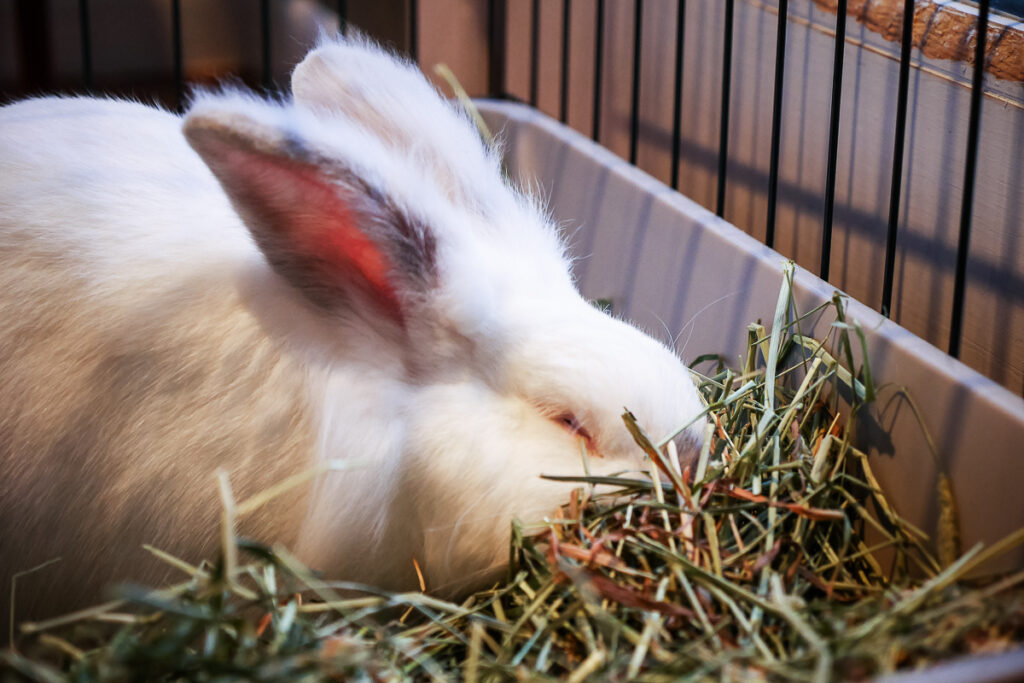In consultation with Cindy McBee, DVM
For years, I have agonized over what to feed the dogs and cats in our family. Researching and analyzing “premium,” “prescription,” “natural,” and even vegetarian foods on the market is time consuming, but having precise knowledge about the quality of ingredients, digestibility, and protein-fat ratio in the various foods has given me confidence that what our animals are eating is making them healthier and perhaps even extending their lives. I had felt frustrated because the same quality and choices were not available to me in rabbit food, but recent reviews of dietary data by veterinarians who treat house rabbits, combined with their practical experience, have changed all of that.Although much of the research on rabbit nutrition has been conducted with more of an emphasis on productivity rather than longevity, even this research makes it clear that we can do a great deal for our rabbits by making sure that what they eat is affecting them positively, rather than contributing to the life-threatening digestive disorders we all fear. While it is not possible to state definitively what the “best” feeding plan is, the experiences of [fosterers, rescuers], and veterinarians have given us valuable information on what works and what doesn’t.
Internal Affairs
To begin with, it is important to understand the way a rabbit’s gut works. Because a rabbit’s digestive system is set up to ingest cellulose in the form of tough, woody stems and fibrous vegetation, it functions best when it has something to work with (Brown 1994). However, large quantities of finely ground feed, sugars, and high levels of carbohydrates can overwork the gut. Therefore, the key to keeping rabbits alive and happy longer is to make sure their digestive tracts stay viable and motile, while striking a balance between indigestible fiber and nutrition.
More Like Horses Than Cats
Like horses, rabbits have long digestive tracts that slowly break down and process cellulose. In the wild, rabbits do not normally eat large amounts of grain, except for certain seasons, or have access to other concentrated foods, just as wild horses rarely find a pail of oats out on the range. Even when in training, horses are never offered free-choice access to grain, and when overfed, a serious condition called colic results.
A similar thing can happen to rabbits when, unable to deal with carbohydrate, glucose, or indigestible protein overload, the cecum becomes impacted. A high-fiber diet helps prevent this condition by stimulating cecal-colic motility. While the fiber in pellets is still fiber, it has been shown that the large indigestible fiber in hay is more effective than small, pulverized fiber at moving food through the digestive tracts of herbivores. It has even been shown that high-fiber diets not only decrease hair accumulation in the gut, but may also have a protective effect against enteritis [Cheeke 1987, 181].
Although “hairballs” are commonly diagnosed in rabbits, they may be less common as a primary complaint (particularly in house rabbits) than was once thought. In fact, rabbits who receive sufficient exercise, plenty of hay and fresh vegetables, and who are not fed pellets free-choice seem to have almost no incidence of hairball at all, even when they are given no petroleum hairball remedy. One reason for this phenomenon may be that both exercise and hay improve gut motility (or the rate at which food moves through the digestive tract). Hay does this because it moves through the gut far more quickly than finely ground feed (Cheeke 88); and exercise because peristalsis increases (in animals and humans) when the body moves. A high-fiber diet combined with exercise should prevent swallowed hair and food from accumulating in the stomach. Interestingly, enteritis does not appear to be as common in wild rabbits, suggesting that the diets and lifestyles of some domestic rabbits contribute to their higher incidence of this disease (Cheeke 1987, 330; Kraus 1984, 236).
The All-Important Hay
In the wild, rabbits eat grass, which is, in its dry form, simply hay. Consequently, hay should be offered in large quantities on a constant basis and should be considered far more than just chewing entertainment. In addition to the invaluable fiber it contains, hay also provides vitamins, minerals, and protein in a form the rabbit’s digestive tract not only can handle, but actually needs for its continued good health.
Many experts advise against giving alfalfa hay to adult rabbits, particularly those who are not under the stresses of a breeding program and hence, do not have the calcium requirements of breeding rabbits. Alfalfa, particularly the tasty leaf part, is higher than most hays in calcium and protein and can, when fed in conjunction with high-calcium feed, cause dangerously high levels of calcium in the system. On a dry weight analysis (more accurate than straight percentages), alfalfa comes out among the highest in calcium content, and lower than most grass hays in fiber. (see Figure 1)
Grass hay, which comes in a variety of types depending on where you live, is a safer choice for older rabbits, especially those with urinary problems. Lower in calcium and protein and higher in fiber, it provides what the rabbit needs without adding what she can do without. In some cases, rabbits who have never eaten grass hay may rebel and hold out for alfalfa. However, if pellets are being rationed and two meals a day of fresh vegetables are being given, the rabbit will become hungry enough between meals to give in and eat the hay. In cases where the rabbit absolutely refuses to eat grass hay, a 50/50 mixture can be given, or alfalfa can be fed as long as the pellets (which are themselves primarily alfalfa) are reduced dramatically.
| Type of hay | dry matter (%) | Digestible Energy (kcal/kg) | Crude Protein % | Crude Fiber % | Calcium % |
| Alfalfa hay | 90 | 1800* | 15.3* | 27.0* | 1.4* |
| Barley hay | 87 | 1790 | 7.6 | 24.0 | .2 |
| Barley straw | 91 | 1580 | 4.0 | 38.0 | .3 |
| Bermuda grass hay | 92 | 1656* | 11* | 27.6* | .4* |
| Clover hay red | 88 | 1760* | 17.3* | 21.8* | 1.3* |
| Clover hay white | 92 | 2024* | 21.4* | 20.9* | 1.8* |
| Lespedeza hay | 92 | 1290* | 12.7* | 28.1* | .9* |
| Oat hay | 88 | 2000 | 7.3* | 29.5* | .3 |
| Oat straw | 92 | 1640 | 4.1 | 37.0 | .3 |
| Orchard grass hay | 89 | 1829 | 9.8* | 30.0* | .3 |
| Prairie hay | 92 | 1670 | 5.3 | 31.0 | |
| Ryegrass hay | 86 | 2070 | 7.4 | 26.0 | .5 |
| Sudan grass hay | 91 | 1860 | 7.3 | 33.0 | .5 |
| Timothy hay | 89 | 2010 | 6.3* | 30.2* | |
| Wheat hay | 88 | 1870 | 7.4 | 25.0 | .2 |
| Wheat straw | 89 | 1340 | 3.2 | 37.0 | .2 |
*Values adapted especially for rabbits by Peter R. Cheeke, Rabbit Feeding and Nutrition, Orlando; Academic Press, 1987. 360-365
Return to the Natural
Important though it is in the diet of a rabbit, hay is only one part of a sound nutritional program. Veterinarians and fosterers who have researched the problem now feel that the way we are accustomed to feeding our rabbits (unlimited pellets and occasional fresh vegetables) may not be the most health- conducive feeding plan. The next article in this series will discuss these issues in detail as we consider that by changing the way we think about our rabbits’ nutrition and giving them the type of food they were meant to eat, we can help them fight off some of the diseases that have killed domestic rabbits for many years. After all, whenever we return to the natural and reject the overly processed and chemically treated, we are taking a step in the right direction.
Works Cited
Brown, Susan. 1994. Care of Rabbits. Working handout for clients. Midwest Bird and Exotic Animal Hospital, Westchester, Il.
Cheeke, Peter R. Rabbit Feeding and Nutrition. Orlando: Academic Press, 1987.
Kraus, Alan L. et al. “Biology and Diseases of Rabbits.” In Laboratory Animal Medicine. Ed. James G. Fox, Bennett J. Cohen, and Franklin M. Loew. Orlando: Academic Press, 1984. 207-240.
Natural Nutrition I: The Importance of Fiber was originally published in House Rabbit Journal Volume III, Number 3.
©Copyright Elizabeth TeSelle. All Rights Reserved. Republished with the permission of the author.

